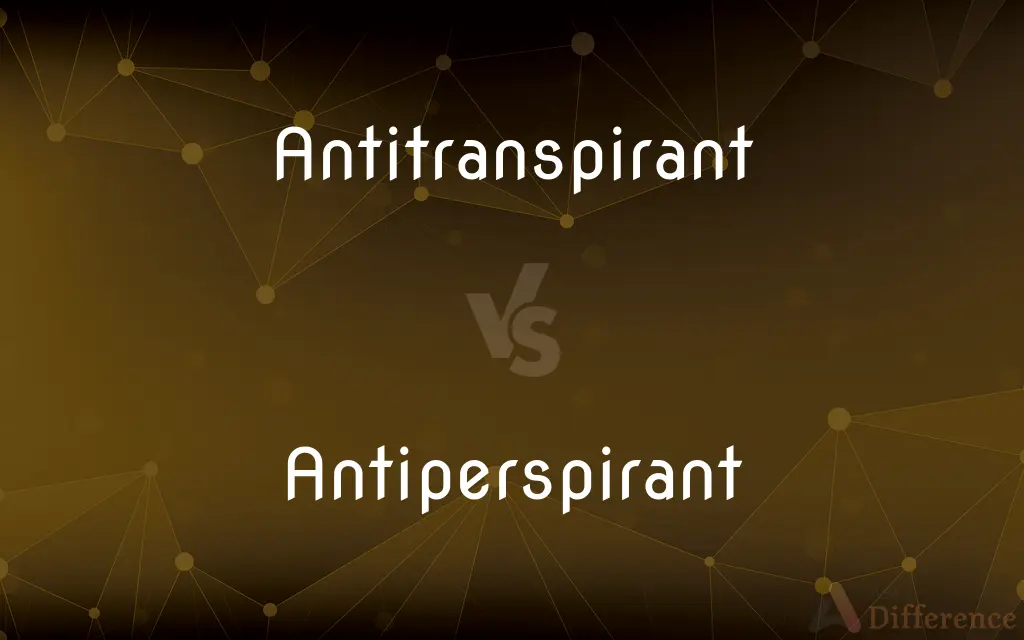Antitranspirant vs. Antiperspirant — What's the Difference?
By Urooj Arif & Fiza Rafique — Updated on April 22, 2024
Antitranspirants are substances applied to plants to reduce water loss, while antiperspirants are used on human skin to minimize perspiration.

Difference Between Antitranspirant and Antiperspirant
Table of Contents
ADVERTISEMENT
Key Differences
Antitranspirants are used in agriculture and gardening to reduce water loss from plants, especially under stress conditions such as drought. On the other hand, antiperspirants are personal hygiene products designed to reduce sweat production in humans, primarily in the underarm area.
Antitranspirants work by forming a barrier on plant surfaces that slows the rate of transpiration, the process through which plants release moisture into the air. Conversely, antiperspirants block sweat glands to decrease perspiration in humans, often using aluminum-based compounds to achieve this effect.
In terms of application, antitranspirants are typically sprayed on the leaves of plants to help them retain moisture during hot or dry conditions. In contrast, antiperspirants are applied directly to the skin, mainly targeting areas prone to sweating.
The main purpose of antitranspirants is to help plants survive water scarcity by reducing transpiration, thereby conserving water. Whereas, antiperspirants aim to reduce body odor and the discomfort associated with sweating, improving personal hygiene and comfort.
While antitranspirants are beneficial in horticulture and agriculture, helping plants manage water resources more efficiently, antiperspirants are used in daily human hygiene routines, focusing on reducing sweat and odor for extended periods of the day.
ADVERTISEMENT
Comparison Chart
Usage
Reduces water loss in plants
Reduces sweat production in humans
Application
Applied on plant leaves
Applied to human skin, especially underarms
Mechanism
Forms a barrier to reduce transpiration
Blocks sweat glands
Composition
Various chemicals, sometimes including films
Often contains aluminum compounds
Primary Benefit
Helps plants manage water scarcity
Reduces body odor and sweat-related discomfort
Compare with Definitions
Antitranspirant
Helps in maintaining moisture within plants.
The gardener applied an antitranspirant to conserve water in newly planted saplings.
Antiperspirant
Used daily by many individuals for comfort and odor control.
Daily use of antiperspirant helps maintain freshness throughout the day.
Antitranspirant
A substance used to reduce water loss through leaves in plants.
Farmers use an antitranspirant spray to protect their crops during drought.
Antiperspirant
Commonly contains aluminum salts to block pores.
Aluminum chlorohydrate is a common ingredient in many antiperspirants.
Antitranspirant
Can be synthetic or organic based on the formulation.
Organic antitranspirants are preferred for sustainable farming practices.
Antiperspirant
Available in various forms such as sticks, gels, and sprays.
She prefers using a spray antiperspirant for quick application.
Antitranspirant
Often used in agriculture and horticulture.
In vineyards, antitranspirants are crucial during unexpected heat waves.
Antiperspirant
Affects only the area where it is applied.
Antiperspirant was effective in reducing sweating on his underarms but not on his palms.
Antitranspirant
Applied externally to plant surfaces.
Antitranspirants are sprayed on the foliage to create a moisture-retaining layer.
Antiperspirant
A hygiene product designed to reduce underarm sweating.
He applied antiperspirant before his workout to prevent excessive sweating.
Antitranspirant
Antitranspirants are compounds applied to the leaves of plants to reduce transpiration. They are used from Christmas trees, on cut flowers, on newly transplanted shrubs, and in other applications to preserve and protect plants from drying out too quickly.
Antiperspirant
A substance that is applied to the skin, especially under the arms, to prevent or reduce perspiration.
Antitranspirant
Reducing transpiration in plants.
Antiperspirant
An astringent preparation applied to the skin to decrease perspiration.
Antitranspirant
A substance applied to plant leaves to reduce transpiration.
Antiperspirant
A substance used to minimize sweating or perspiration, and usually applied to the underarm area.
Antiperspirant
An astringent substance applied to the skin to reduce perspiration
Common Curiosities
What is an antitranspirant?
An antitranspirant is a substance applied to plant leaves to reduce water loss through transpiration.
Can antiperspirants cause skin irritation?
Yes, some people may experience skin irritation or allergic reactions to antiperspirants.
Can antitranspirants affect plant growth?
If used excessively, antitranspirants might hinder plant growth by overly restricting transpiration.
What are the main ingredients in antiperspirants?
The primary ingredients usually include aluminum salts, which help to reduce sweating.
Do all antiperspirants contain aluminum?
Most conventional antiperspirants contain aluminum, but there are aluminum-free options available.
Is there an organic alternative to antitranspirants for plants?
Yes, there are organic antitranspirants made from natural materials like pine oil or wax.
How long does antiperspirant effectiveness last?
It varies by product, but some antiperspirants can offer protection for up to 48 hours.
Can antitranspirants be used on all types of plants?
It's best to consult product guidelines, as some may not be suitable for all plant types.
How often should I apply antiperspirant?
Typically, antiperspirant is applied once daily, but it may vary based on personal needs and the product's effectiveness.
How do antiperspirants work?
Antiperspirants work by blocking the sweat glands with aluminum-based compounds to reduce perspiration.
Are antitranspirants safe for all plants?
Most are safe, but it's essential to choose the right type for specific plant species and environmental conditions.
Why use an antitranspirant on plants?
Antitranspirants help plants survive during drought by conserving water.
Can I make a homemade antiperspirant?
Yes, there are recipes for homemade antiperspirants using natural ingredients like coconut oil and baking soda.
Are there any health concerns associated with using antiperspirants?
Health concerns primarily relate to the aluminum content, which some studies suggest could be linked to certain health issues, though definitive evidence is lacking.
What are the environmental impacts of antitranspirants on plants?
They are generally considered safe but should be used responsibly to avoid affecting the local ecosystem.
Share Your Discovery

Previous Comparison
Mislead vs. Misinformed
Next Comparison
Cynophilist vs. CynophileAuthor Spotlight
Written by
Urooj ArifUrooj is a skilled content writer at Ask Difference, known for her exceptional ability to simplify complex topics into engaging and informative content. With a passion for research and a flair for clear, concise writing, she consistently delivers articles that resonate with our diverse audience.
Co-written by
Fiza RafiqueFiza Rafique is a skilled content writer at AskDifference.com, where she meticulously refines and enhances written pieces. Drawing from her vast editorial expertise, Fiza ensures clarity, accuracy, and precision in every article. Passionate about language, she continually seeks to elevate the quality of content for readers worldwide.















































